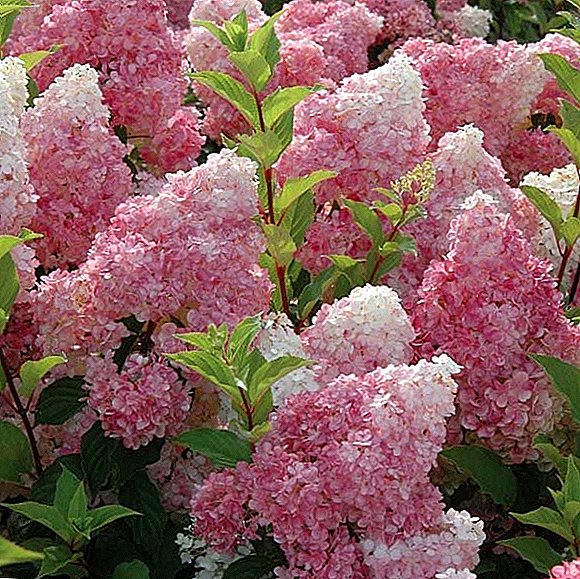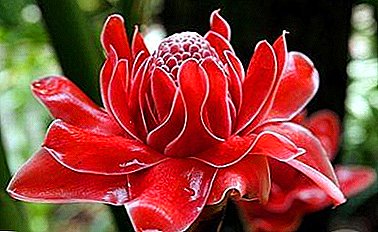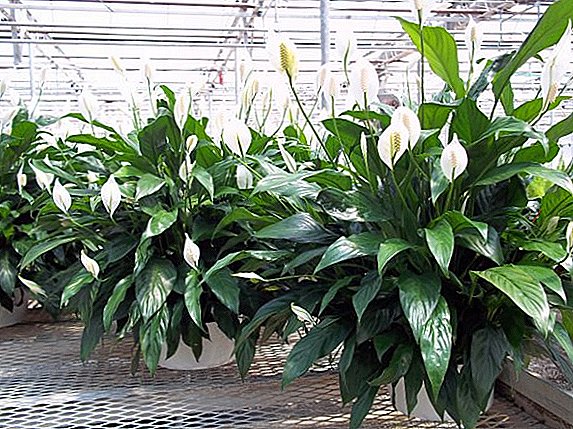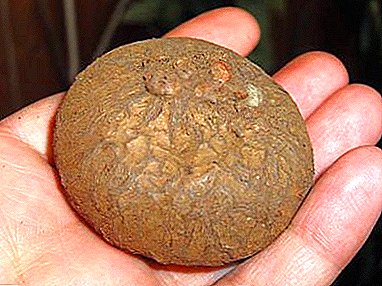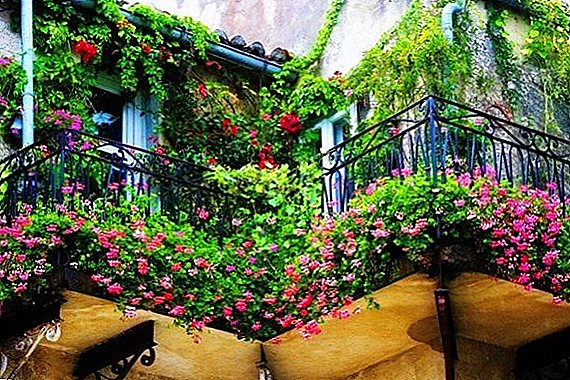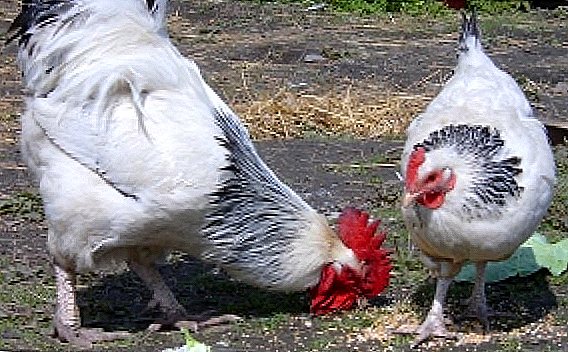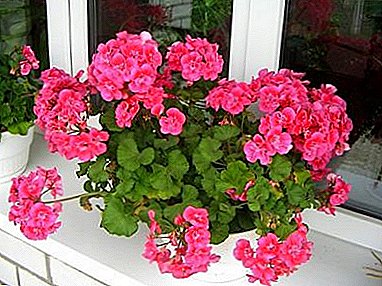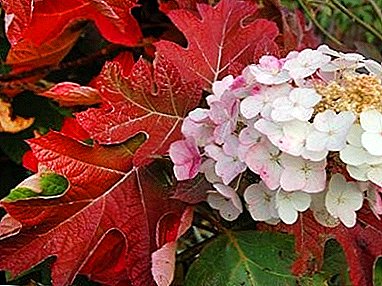
The ornamental shrub that can easily become one of the main decorations of your garden is the hydrangea is oak-leaved. It comes from North America and is still new for Russian gardeners.
Oakolistnaya hydrangea - elegant, resistant to adverse weather conditions, a plant that attracts everyone's attention both during the flowering period and outside it.
Description
This plant is large deciduous shrub, which can reach a height of 2 m. Its “zest” is pleasant to the touch textured, large 7-lobed leaves, the shape of which is close to the shape of oak leaves. Such leaves are the main difference dubolistnoy hydrangeas from other varieties of this shrub. The edges of each piece of hydrangea sharp, with notches. Sheet size - up to 25 cm Fresh shoots and young leaves are covered with a light white fuzz that disappears with time, remaining only on the wrong side of the leaf.
REFERENCE: In the warm period of the year, the leaves of the shrub have a dark green color, which by autumn is replaced by a rich crimson, which makes it beautiful even in the period of fading.
Not only leaves attract gardeners to hydrangea - it is very beautiful blooms. Its flowers are large inflorescences-panicle small white flowers with a size of 3 cm, collected in a cone. Shrub blooms for a long time: from June until the autumn.
The trunk of a hydrangea is straight, woody at the base, branches well. Shrub grows very quickly - in just three years you can grow a luxurious lush plant from a sapling, as the shoots have time to stretch out in one year up to 50cm.
The root system is branched, shallow.
Climate
On the whole, the hydrangea is oak-leaved - a frost-resistant plant, but in central Russia without frosting, it can freeze. Winter hardiness zone - up to -29С. This plant feels best in the southern regions of the country. There are cases when the kindergarten wintered well in the Moscow region.
ATTENTION: Young plants should must cover for the winter or repot it in a pot and keep it indoors as an indoor flower during this time of year. With age, shrubs tolerate cold much better.

Sorta
There are several varieties of shrubs, the two most common are "Harmony" (Garmony) and "Applause" (Applause).
Hydrophobic oak Harmony has spherical or flat large inflorescences with a diameter up to 20 cm. Flower petals have a white or cream color.
Hydrophobic oak Applause reaches in height 2 m and has large inflorescences of snow-white color. Sterile flowers are larger than fruit bearing ones.
Planting and care
With proper care, it does not require complex manipulations.
Landing
Planting in the ground is made in the spring, while in the hole, partially filled with fertile soil - for example, red peat, pine litter; the plant does not set too deep, the root system is covered with earth. Around the trunk of the ground need to slightly tamp and shed. While the hydrangea is taking root, it is important to have good watering and shade.
Priming
This plant is capriciously related to the ground - does not tolerate lime. Shrubs should be planted in loose, fertile, drained acidified soil. Acidifying the soil costs about 2 times a month with fertilizers. Optimal level pH for oak-leaved hydrangea - 4,5-6,5.
Watering
The soil in which this shrub grows should always be hydrated, therefore it should not be allowed to dry out. Will help keep the necessary microclimate mulchingwhich is produced annually. Water the plant must be separated by warm water: under one bush - about 3 buckets.
Light mode
> Properly chosen place for planting hydrangea is the key to success. The plant should not be under the scorching rays of the sun. The ideal place for planting a shrub is a slightly shaded or shady place in the garden.
IMPORTANT: The amount of light will not affect flowering shrubs.
Thermal mode
Hortensia patiently refers to temperature extremes, but it is not worth overcooling the plant once again.
Most of all, this plant is afraid of spring frosts.
Fertilizer and dressing
To the plant grew well and pleased you with a lush crown and flowers, its it is important to fertilize properly both organic and mineral fertilizers with a high content of iron and magnesium. Complex fertilizing plant is important at the time of planting and during active growth, that is, twice a year.
Top dressing is made at the end of spring or early summer with complex mineral fertilizer (superphosphate, urea and potassium sulfur in the amount of 20g, 10g, 10g, respectively), then the plant is fed every two weeks until July.
ATTENTION: Top dressing stops in July, as the shoots of the shrub should have time to woody before winter.
Do not overdo it with fertilizers, otherwise the inflorescences will become too large and heavy - hydrangea branches may break.
Breeding
Hydrangea reproduces in several ways: cuttings, dividing bushes, seeds, grafting.
Cuttings root well in July, when the flowering period comes. Rooting occurs within 4 weeks under optimal conditions - shading and temperature. from 16 to 20C.
IMPORTANT: Lignified shoots root poorly and are not suitable for grafting.
Plant propagation dividing the bush produced in spring or autumn: for this, the hydrangea is removed from the soil, divided into several parts so that each one has several buds of renewal.
Grow this shrub from seeds difficult, but if you decide to try to do this, then try to create all the necessary conditions: the seeds should be sown in a box in the soil of humus, peat, sand, and then regularly watered with a spray bottle. If the seeds were sown in spring, they will ascend in about a month, and by the fall the young plants will reach up to 40 cm in height.
Pruning
Pruning is done in the spring - until fresh leaves are bloomed, all weak, damaged twigs are removed from the plant, and powerful shoots are shortened, leaving only 2-3 pairs of buds. In the summer, the plant removes inflorescences that have already bloomed - this will give an opportunity to bloom young.

Wintering
Hydrangeas is important to ensure proper wintering: in the first year of life a young plant is necessaryto get to the pot and keep in a warm room. In mid-December, the wintering shrub loses foliage and retires. During this period, it is worth moving the bush to a dark corner of the room and reduce the frequency of watering. Awakening occurs in April - buds begin to swell on the branches of a bush. During this period, hydrangea must put on the windowsillso that the plant gets enough light. Watering during this period should be done with the addition of fertilizer to the water. Back to the garden plot shrub lands in May.
In the southern and western regions of the country, hydrangea can not dig for the winter, but be sure to cover. This procedure is performed in dry weather in autumn - in October-November. The branches of the plant must be bent to the ground and covered with a covering material. The same material or spruce frail and laid under the stems. On top of the covering material it is necessary to pour peat layer about 15 cmby covering it with film.
ATTENTION: When it comes time to release the hydrangea from the wintering "tent", do it gradually. Fully bush only opens when the danger of sudden frosts will be left behind.
Diseases
Hortensia is a disease-resistant plant, but among them there are those with whom the shrub cannot handle - this gray mold, fungal diseases, scientific dew. The reason for such dew is increased humidity, it is treated by normalizing the microclimate around the plant.
Also shrub prone chlorosis - yellowing of leaves. Its reason - the excess amount of lime in the soil. It is treated with supplements with iron salts.
Among insects can cause great damage aphid, ostronosik, spider mite and weevil. Spraying with karbofos, Aktellik and other drugs will help to get rid of small pests.
With proper care and cultivation, the oak-leaved hydrangea will delight you with its beauty for a long time - even without flowers, this plant amazes with its richness, showiness and will definitely become the highlight of your garden.
Now this shrub is gaining popularity and is increasingly appearing in the flower collections of professional gardeners.
A photo
See Hortense dubolistnuyu photo:



